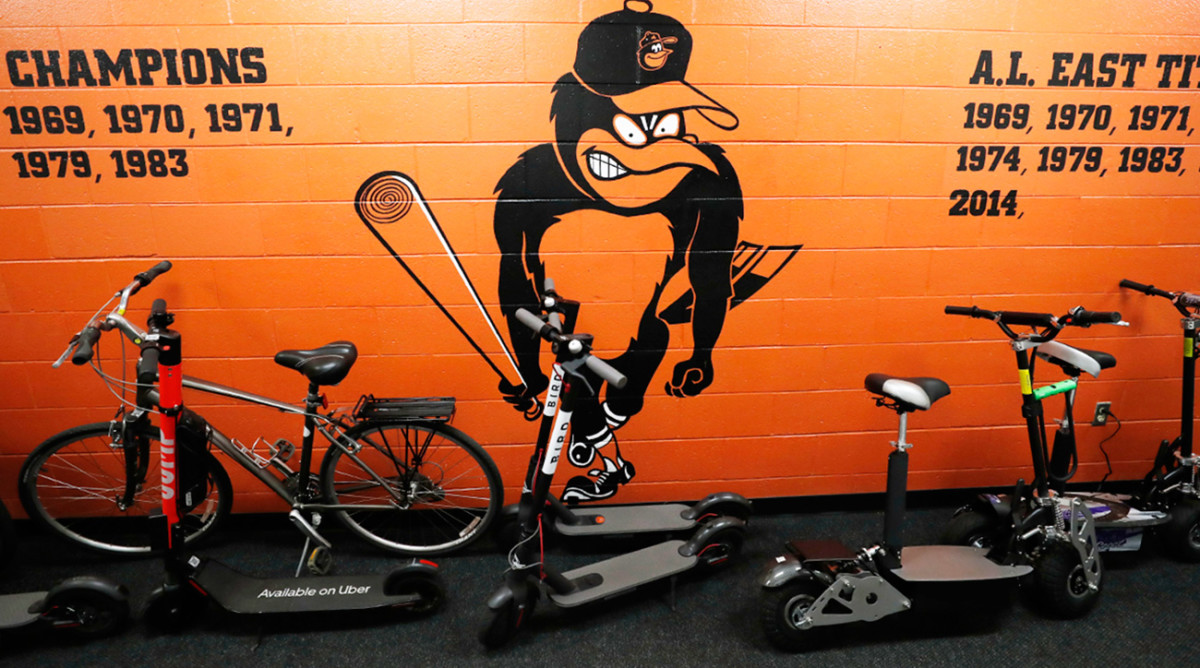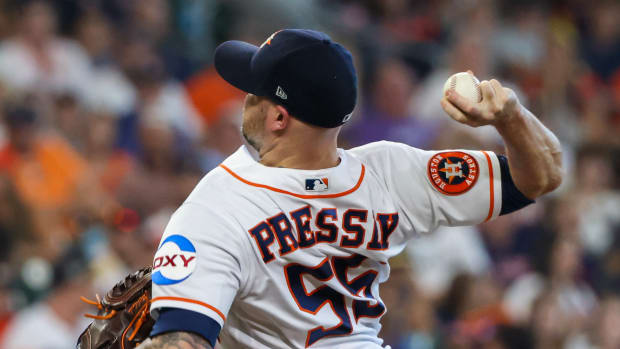The Orioles Are Riding Scooters to Navigate a Difficult Season

BALTIMORE — Richie Martin has had the car of his dreams for less than a year, but he has only driven it once in the past month. The infielder bought a white Tesla last August and imagined life as a big leaguer, cruising around in style. Then he debuted with the Orioles and learned that his teammates prefer two wheels.
It’s easy to find a space in the players’ parking lot at Oriole Park at Camden Yards these days. The real fight for real estate is in a hallway between the clubhouse and the video room, where against a wall rest a dozen electric scooters.
“It may be the lamest biker gang of all time,” says rightfielder Trey Mancini.
Reliever Mychal Givens recoils at that characterization: “The lamest? No, it’s gonna be the coolest.”
Mancini is probably closer to the truth. To be clear, these vehicles do not conjure images of windswept Italians on Vespas. A few of the scooters have seats—“way cooler” than the ones without, Givens insists—but for the most part, these are the grown-up versions of the Razor scooters every self-respecting child of the early aughts rode to school. You have probably seen them strewn across sidewalks in cities across the country. In an attempt to add to the cool factor, the Orioles eschew helmets.
“I don’t know if I should advertise that,” Mancini says. “I’m thinking about hopping on the helmet bandwagon.”
The origin of the Orioles' trend is unclear. Reliever Miguel Castro seems to be Patient Zero in Baltimore; he picked his up last season out of a desire to avoid traffic near the ballpark. Mancini followed shortly behind after a founder of Bird—one of the companies that make popular rental versions of the scooters—caught an O’s game.
“The streets here are all one-way,” Mancini laments. “It’s much easier to scoot here.”
Catcher Jesús Sucre first became enamored of them around the same time, in Tampa, when reliever Sergio Romo bought a dozen of them as gifts for teammates and staff. Sucre has heard of other players who ride them—Giants reliever Mark Melancon, for one, and Rangers outfielder Hunter Pence—but, he says, “This is the biggest team in scooters.”
Sucre’s is actually a two-scooter family: He keeps the one Romo bought him at his offseason home in Miami, then added a second to his collection when he arrived in Baltimore as a free agent this offseason. “I live, like, two blocks from here,” he says. “So it makes sense.”
And that may be the real reason the scooters have caught on. This is among the most transient teams in baseball: Nine of the 25 players on the active roster have joined the team within the past nine months, and everyone is aware that a club FanGraphs projects to win 60 games could be further torn up and sold for parts at any moment. Most players have not put down roots in the suburbs. They live in apartments near the ballpark and shuttle back and forth. The farthest Martin has found himself from work is a local Best Buy.
So they have established what they refer to as Bike Gang. Half a dozen players live in Sucre’s apartment complex, and they scoot home from games together. Givens has begun looking into leather jackets, which he hopes to have embroidered with BIKE GANG on the back and player names on the front.
“We’re gonna show up in a Flying V formation,” says Mancini.
The rules of Bike Gang are not entirely clear but include the stipulation that a player must own, not rent, his vehicle. That excludes leftfielder Dwight Smith Jr., who hops a rental scooter in the afternoons on the way to work.
“Don’t let him fool you,” says Givens disdainfully. “He’s not in the gang yet.”
And so the Orioles wake up in their rental apartments and spend their days trying to keep a bad team afloat. They take batting practice and throw bullpen sessions and work just as hard as the players on a good team do. They slog through a game that usually ends in a loss. Then they change into street clothes, hop aboard a device initially marketed to small children and peel off at the breakneck pace of 15 to 20 miles per hour.




































